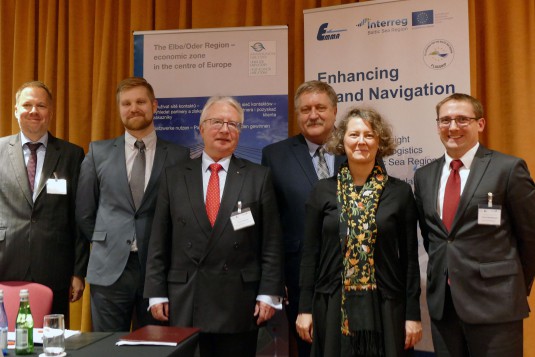

First annual EMMA conference brought Baltic partners together
Around 130 participants from around the Baltic Sea Region gathered in Warsaw to discuss how to enhance inland navigation.
European cooperation is necessary in order to integrate inland waterway transport better into the multimodal logistic chains.
This opinion was shared by around 130 participants from Poland, Germany, Sweden, Lithuania, Finland, Belgium and Czech Republic, who gathered this week in Warsaw to discuss the enhancement of inland navigation in Europe.
“The added value from EMMA is that it brings all the Baltic partners together around the same table. It is important to cooperate and come closer to each other. There is more that we share than what divides us”, encouraged Karin de Schepper, Director of Inland Navigation Europe.
The potential of inland navigation is not yet fully utilized regardless of the benefits it carries. Inland navigation is cost-efficient, safe and environmentally friendly mode of transportation that provokes growth. Some important steps have already been taken in promoting it, for instance the creation of an EU waterway transport action plan NAIADES. Waterways are already integrated in the Trans-European Transport Networks (TEN-T), but appropriate financial framework to support the role of ports in TEN-T is still required from the EU.
”We also have need of policies supporting combined transport and burdenless regulatory framework for the sector”, reminded Roland Hörner, President of European Federation of Inland Ports.
EU aims to shift 30% of long-distance freight traffic from road to rail and inland waterways, as well as to have carbon-free city logistics by 2030. Enhancing inland waterway transport can contribute to improved environmental status and help to reach sustainability objectives.
“Changing patterns is not an easy task, but we want to change them so that inland navigation would have a higher share in transportation”, said Maciej Brzozowski, Head of the Port of Hamburg Marketing Representative Office Poland and Lead Partner of EMMA.
Port of Hamburg is nowadays the second biggest inland port in Germany. Since road and rail infrastructure is in some parts of the Baltic Sea Region overloaded, inland navigation with its huge potential offers a unique chance for expansion.
“Roads do not have enough capacity for rising amounts of hinterland traffic. The use of inland navigation will create capacity, so we are preoccupied with developing inland navigation”, confirmed Stefan Kunze, Chairman of the Board at Elbe Allianz and Representative of Port of Hamburg Marketing Office Dresden.
Speakers and panellists of the conference emphasized that inland water transport has to co-exist with other transport modes.
“Inland waterways have to be upgraded and inland navigation layer be seen as combined with seaports, inland ports, railways, motorways and logistic centres”, stressed the keynote speaker Dimitrios Theologitis, Senior Expert at the European Commission’s DG MOVE.
Theologitis highlighted the importance of DINA, the digital inland navigation area, since digitalisation of logistics will improve information flows and assist in seamless logistic changes and the operation of the waterways. A lot of content is already in an electronic form, such as electronic charts, notices to skippers and vessel databases.
“Instead of having fragmented pieces of information we have to make them work together”, Theologitis stated.

Mr. Stefan Breitenbach, Head of Project Development, Port of Hamburg Marketing
Email: breitenbach@hafen-hamburg.de Tel: +49 40 37709 121